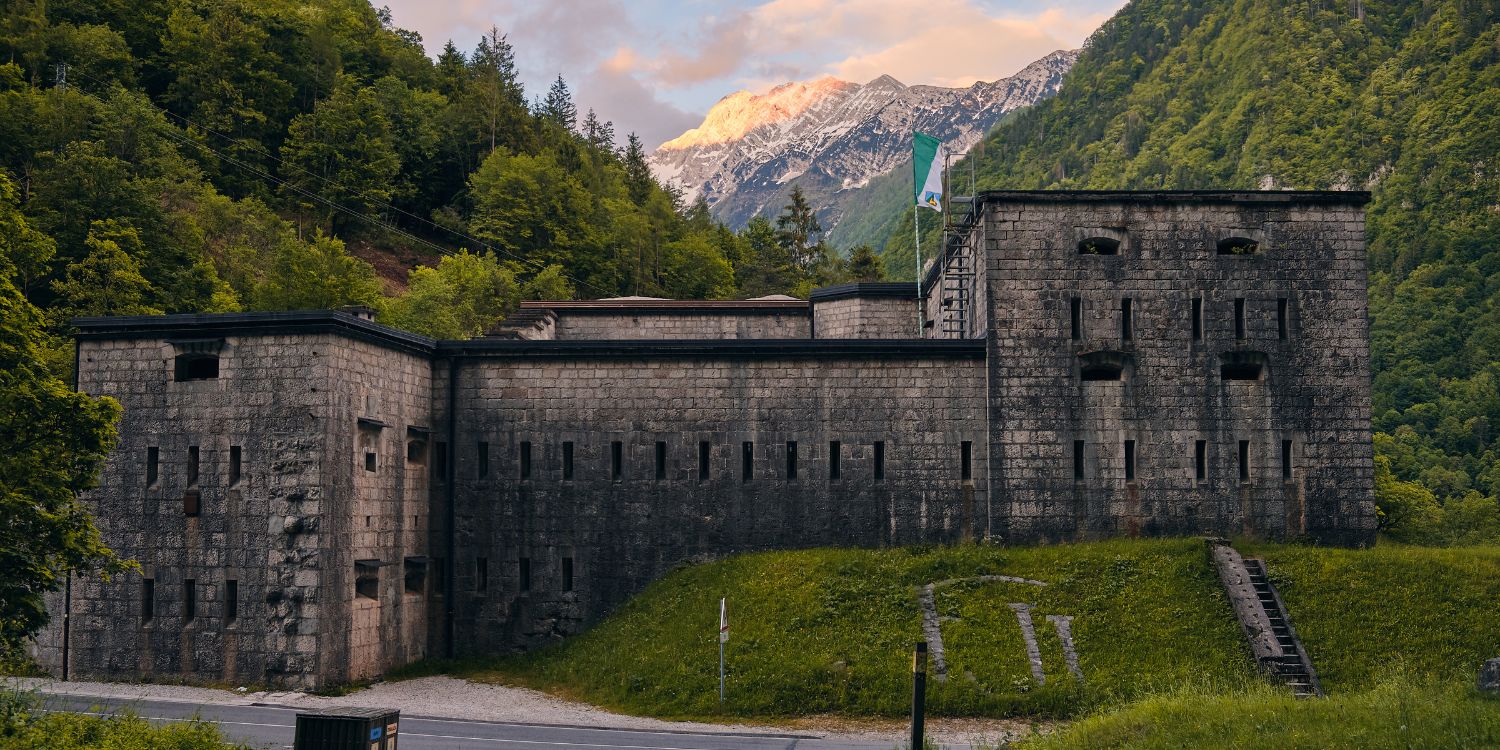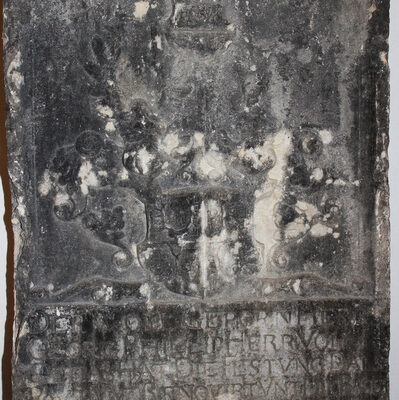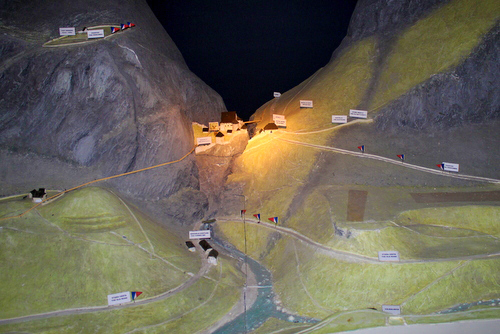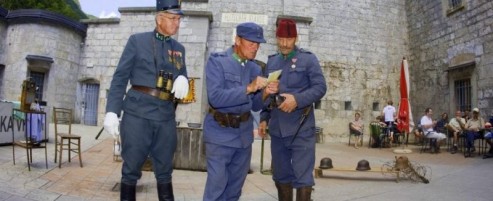
14 Feb Bovec, Kluže Fortress
One of the most interesting sites in our valley is Fortress Kluže. Old stronghold, placed between steep slopes of the surrounding mountains and deep gorge of the cold Koritnica River, is really worth a visit.
Above the gorge of the Koritnica River, in the narrowest part of the valley, stands the Fortress Kluže. In its museum you can see an exhibition on the history of the fort.
Fortress Kluže had a role of protecting an important road between Cividale del Friuli in Italy and Austria all through its long history. The fortress is strategically secured by the slopes of Mt Rombon and Mt Sleme and below it descends the steep gorge of the Koritnica river.

PREHISTORY AND ANCIENT ROME
Part of an ancient Amber Road once led past Kluže. Amber Road was a net of important trade routes between the Baltic Sea in the northern Europe and Italy in the south. Along this road the first European traders were carrying the precious amber jewelry and decorations, as well as wine, olive oil, salt and slaves.
At the time of ancient Rome old Amber Road became an important Roman road. Linking the Roman river port Aquileia with the countries of Celtic Noric Kingdom in Carinthia. Noric kingdom was rich with high value copper and iron ore and Noric weapon was considered the best in the world.
VENETIAN REPUBLIC
The first wooden fort in Kluže was built by the Venetians as a defense against the Turks. They constructed a wooden bridge over the gorge of the Koritnica river. In the 15th century the entire Europe was terrorized by the hordes of invading Turks. They took all the food, animals, sold locals as slaves and kidnapped children.
Local legend tells that just before the arrival of the Turks, Venetian soldiers who were housed in Kluže, damaged the wooden bridge across the river Koritnica. At dusk the Turks rushed past the Fortress. When they approached the bridge was already dark and none of them had seen that part of the bridge is missing. So the Turks, one after another fall into the abyss. But then horses smelled the danger and refused to go on wards.
BOVEC LANDLORDS
Shortly after the end of the Turkish invasions, a war for territory started between the Habsburgs and the Venetians. The Upper Soča valley also found itself in the focus of this war. The armies have repeatedly clashed for the fort in Kluže and finally the Venetians were forced to surrender it without a fight.
The Austrians have established Bovec governorship. Landlord lived in Kluže castle. Wooden fort was rebuilt to a greater one of stone. One of the most popular Bovec landlords was George Philip von Gerra.
He undertook the extensive restoration of Kluže, amplify the walls, discovered a reservoir of fresh water below the fortress and brought water even in the castle through wooden pipes. In the wedding hall on the first floor of Kluže you can still see a stone plate with von Gerra’s family ensign. This plate was built in the walls of the fortress by von Gerra when reservoir of fresh water was discovered.

NAPOLEONIC WARS
Despite the doubts of the French military leadership, the young Corsican general organized a very successful military expedition in Italy. His plan was to join all the small countries that Italy was divided to and bring them together in a single country. At the same time, he of course wanted to form an alliance between Italy and France against their eternal enemies Austrians.
Napoleon achieved a great victory in Italy and the Austrian army started retreating back to Austria in panic. Part of this army fled through Kluže to Carinthia, followed by the French. In local stories the legend of the damaged bridge appears again. Austrians have allegedly damaged the wooden bridge over the Koritnica river. The French army rushed across the bridge in the dark of the night with full force. Before they realized that there’s something wrong with the bridge, many soldiers fell into the abyss. Only when the drummer fell into the abyss, the French realized the sabotage.
Nevertheless, the French conquered Kluže castle with artillery attack and forced the Austrian crew to surrender. Castle was burning for 3 days, but has not been fully damaged.
A part of Kluže Museum exhibition is also a model that demonstrates the battle of Austrians against the French.
A few years later Napoleon’s troops passed Kluže again. This time without a fight. Austrians set their defence at Predel Pass Fortress where Captain Hermann and his men showed a great deal of courage in tragic events.

ISONZO FRONT
In preparation for the First World War the Austrians built a strong military fortress in Kluže. Together with five other Carinthian fortifications it protected Austro-Hungarian Monarchy against the Italian army. In 1882, they opened the renovated fort and for that occasion the Austrian Emperor Franz Joseph I visited Bovec. Today you can still see the inscription initials of his name FJI set up of stones on the lawn in front of the fortress. They remain here from the days of Emperors visit.
But the Kluže Fortress had a big disadvantage at the outbreak of the Isonzo Front. It was built before the use of iron reinforced concrete and therefore was out-of-date. Its stone walls would not withstand the missiles from the grenades which were novelty in the 1st world war. Therefore, the Austro-Hungarian military authorities decided to build a new, modern Fort Hermann higher on the slope of Mt Rombon.
Because the Italians failed to occupy Mt Rombon during the two-year battles of Isonzo or break the Austrian defense on Ravelnik hill, the fortress of Kluže was not hit by even one of the Italian grenades. It was lying in their blind spot, despite the fact that the nearby road to Bavšica was badly devastated.
During the Soča battles the fortress housed the military back office – first aid station and kitchen, a telephone central in the basement and postal pigeons in the yard. At the end of 1st world war the fort was abandoned.

KLUŽE MUSEUM
Today, Kluže Fortress hosts a museum. In it you can see a permanent exhibition on the history of the fort and the collection of artifacts from World War 1. On the first floor there is a wedding hall with the famous von Gerra stone plate. Below the fortress, you can still find the reservoir of fresh water.